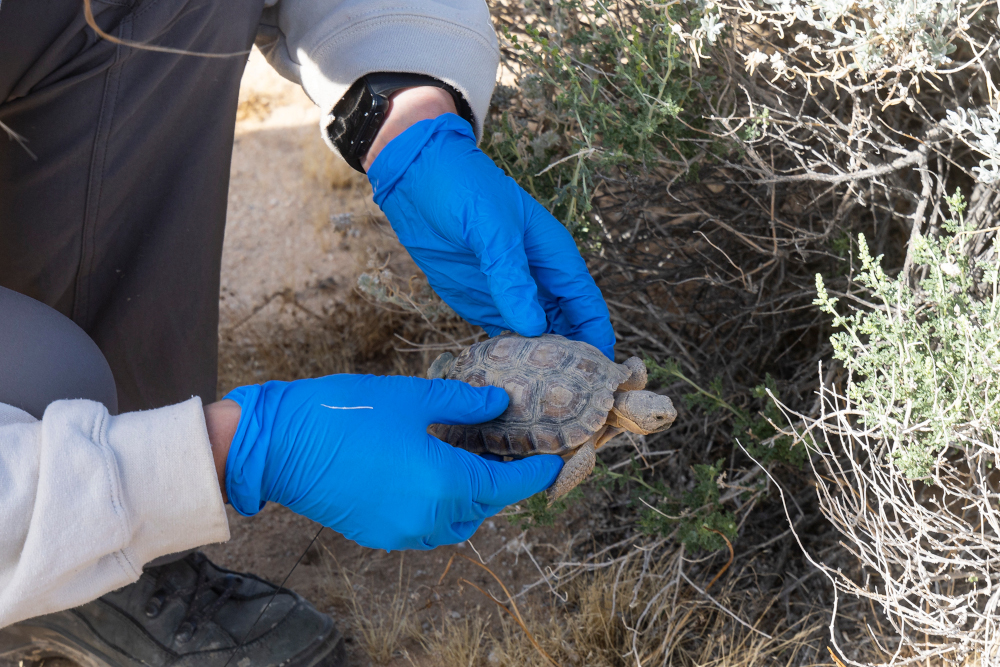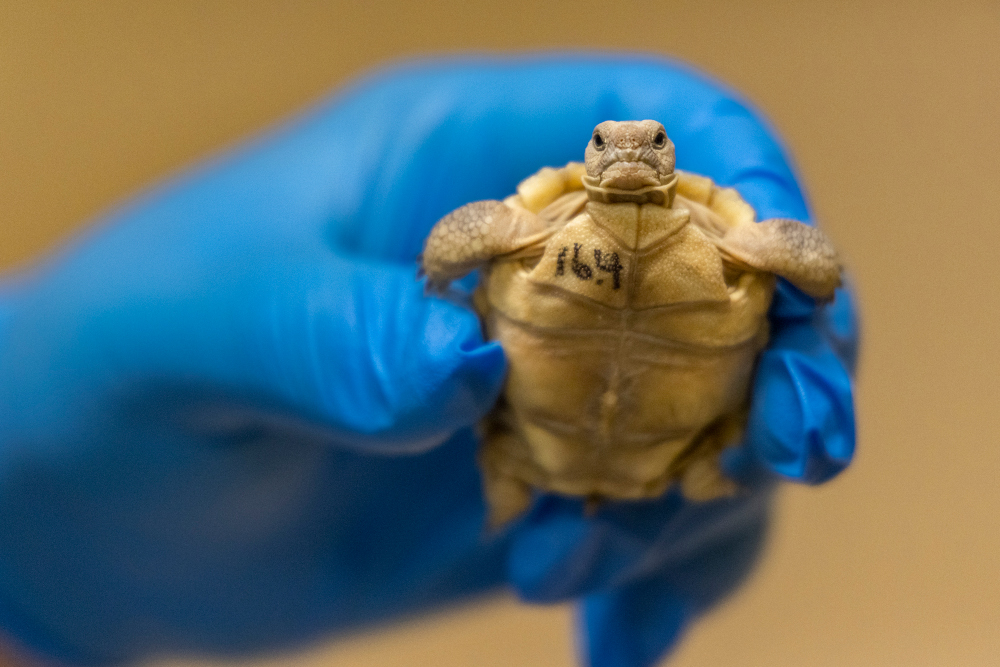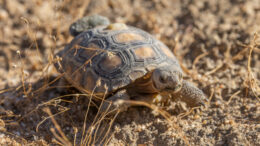Last November conservationists carefully carried 70 young, critically endangered Mojave Desert tortoises to the reptiles’ natural habitat on Edwards Air Force Base in Southern California. The tortoises had been hatched and reared in captivity, and the team — a collaboration between U.S. Air Force officials at the base, San Diego Zoo Wildlife Alliance, and The Living Desert Zoo and Gardens in Palm Springs — were hopeful that the animals would survive the rigors of life in the wild, where ravens would try to peck through their shells and coyotes could attack them.
It would take a while to learn how they fared: Soon after their release, the reptiles would hide in underground burrows and go into brumation, a state of inactivity, for the winter.
But six months later, this past April, news of their fate came out: The tortoises had emerged from their burrows healthier and stronger than ever, a notable milestone in the ongoing tortoise conservation story.

The news quickly made headlines around the country. Local outlets covered the outcome, as did the Associated Press, which transmitted it internationally. Even celebrity-focused People magazine profiled the project. The media blitz demonstrated that even though conservation projects can be expensive and time- and energy-intensive, concerted efforts to help species come back from near extinction, and even thrive, can work.
Dozens of conservation success stories come out every year, from bald eagle population surges to black-footed ferret births, zebra shark releases to red wolf habitat protections. Yet few get as much publicity as the tortoises did in the spring.
So why did the story of the tortoises resonate so widely when so many other conservation stories fail to reach the public? The answer may reflect not only the state of human views on our effect on the environment, and our opinions of animals, but also the state of the news industry and what we cover.
“A Huge Downer”
Research published in 2022 by Carlos Corvalan, an advisor on risk assessment and global environmental change at the World Health Organization, suggested that people often feel overwhelmed by today’s biodiversity and climate change crises, which can lead to feelings of helplessness and result in people taking less action, not more.
Bad news about habitat destruction, the effects of greenhouse gas emissions in our atmosphere, and struggling species abound. The public, it seems, is hungry for positive stories.
“In this time, in all times, conservation can be a huge downer,” says James Danoff-Burg, director of conservation at The Living Desert Zoo and Gardens. The tortoise story, however, was about how the reptiles did well in their new environment after months in brumation. “This,” he says, “is a success.”
Another reason that the tortoise story got so much traction may be because they’re cute and unthreatening. Unlike endangered predators, tortoises won’t hurt anyone or take down prey with their fangs. Studies on stories about hyenas and sharks, for example, show that conservation focused on those species is less popular among certain age groups who think of them as scary.
Although tortoises may not qualify as charismatic megafauna — typically thought of as popular, attractive, and well-known animals — they have endearing features and are charmingly awkward.
“We relate to those big eyes,” says Danoff-Burg. “Tortoises, they’re just so funny and odd and alien, but adorable. I think that sold the story as much as anything.”

The groups involved also have communications departments that helped narrate the story of the species the organizations care for. Typically it’s up to the researchers themselves to relate successes in the field, but media departments can help tell those stories to a wider audience, says Melissa Merrick, associate director of recovery ecology at San Diego Zoo Wildlife Alliance.
“They really did a great job in elevating the work that we’ve been doing,” she says. “Not every organization is fortunate to have such a great communications team, and that’s really something that’s overlooked in a lot of conservation work, the importance of getting the story out there and letting people know some of the wins.”
Can the Tortoises’ Media Success Be Duplicated?
If conservationists or public relations professionals want to replicate the Mojave Desert tortoise story success, the task may be difficult, says Betsy Hildebrandt, senior vice president of external affairs for the Association of Zoos and Aquariums. “A great, compelling story often doesn’t land, while one that seems insignificant can have legs,” she says.
In her more than three decades in communications, she’s seen how uncontrollable factors often influence the amount of publicity a study or a success will have in the media. Those can include a heavy news cycle, whether a reporter or editor has interest in a particular species, or whether viewers think the species is cute and cuddly.
“The best a PR department can do is put together a compelling pitch, be smart and target reporters who may have covered something similar in the past, [and] try an ‘exclusive,’ which you can then promote on social media to get further pickup,” she says.
Success Stories Have Power
In the void of good news, the doom and gloom stories often earn more attention, so the conservation community should promote even small victories.
“There are so many successes out there,” Danoff-Burg says. “We just don’t tell those stories very well.” We often fail to advertise minor wins in a conservation success story, such as efforts to mitigate threats like roads or poaching.
Some in the media understand that dynamic, which has led organizations like the Solutions Journalism Network to advocate for stories with a positive message that can show readers why, and how, people responded to a particular problem.
Sure, sometimes even good-news stories fail to make a splash. But even if a conservation story doesn’t grab the public’s attention the first time there’s a breakthrough, a species’ comeback could become an even more compelling narrative over time.
Take the black-footed ferret, for example. The species was thought to be extinct by the early 1980s, until a rancher’s dog found one in the wild a few years later. Biologists named the ferret Willa and collected her genetic material. Decades later they created her genetic clone in 2021 to help the species recover. The news of the genetic advance made national headlines in places like Science, National Geographic, and Smithsonian Magazine. Biologists just recently used that same genetic material to create two more younger sisters, also clones, generating yet more headlines.
View this post on Instagram
The organizations that contributed to the Mojave Desert tortoise success could have more news to promote in the future, too, as they continue their research, like what makes a tortoise clutch successful, whether specific females are likely to produce young that succeed in cold weather, and whether individual differences in behavior change how they respond to predators. That could all make conservation efforts more effective on a faster timeframe, Danoff-Burg says.
As researchers and biologists increase their knowledge of how to best protect and support lots of other threatened and endangered species — and the habitats they rely on — conservationists will have more tales to tell of their successes. That could benefit both humans and animals alike.
After all, everyone loves a good story.

Previously in The Revelator:
Breeding the ‘Snot Otter’


